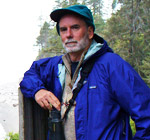Wake Audubon announced the creation of two awards that will recognize extraordinary volunteer efforts and environmental stewardship carried out by our volunteers. The PAULETTE VAN DE ZANDE VOLUNTEER AWARD honors Paulette for her many years of contributions to governance, fellowship, and fund-raising for Wake Audubon. The JOHN CONNORS CONSERVATION & ENVIRONMENTAL EDUCATION AWARD honors John for his leadership in many of Wake Audubon’s conservation initiatives and his commitment to environmental education.

The full document creating the Paulette Van De Zande Volunteer Award reads as follows:
WHEREAS, it is the desire of the Board of Wake Audubon Society to honor and show gratitude to Paulette Van de Zande for her commitment and many years of volunteer service; and
WHEREAS, Paulette has been a loyal and devoted member and Board member of Wake Audubon Society since 1978; and
WHEREAS, Paulette has baked homemade cookies and cakes for refreshments after nearly every monthly meeting for more than 30 years, donating both time and years of expenses to this endeavor; and
WHEREAS, Paulette worked to support Wake Audubon activities through her membership in the Raleigh Garden Club by planning birding outings and asking for financial support for various projects from their members; and
WHEREAS,Paulette supported other Wake Audubon fundraising projects by seeking in-kind and financial contributions; and
WHEREAS,Paulette manages her home landscape for wildlife in addition to feeding and sharing wildlife observations in her yard and garden with others; and
WHEREAS, Paulette’s actions embody the spirit of the Wake Audubon mission, “To foster knowledge, appreciation, and enjoyment of nature; to encourage responsible environmental stewardship; to conserve and restore natural ecosystems, focusing on birds, other wildlife, and their habitats, for the benefit of humanity and the earth’s biological diversity.”
NOW, THEREFORE, BE IT RESOLVED, that Wake Audubon Society hereby establishes the Paulette Van de Zande VOLUNTEER AWARD. Through the establishment of this Award, members and friends of Wake Audubon Society hereby convey the deepest expression of gratitude and appreciation for the volunteer contributions of Paulette. Recipients of the Paulette Van de Zande VOLUNTEER AWARDwill be chosen by a suitable committee of Wake Audubon Society members on an annual basis (or as otherwise deemed appropriate). The recipient will embody a similar spirit of fellowship with others as a result of sharing common attitudes and interests and will demonstrate a commitment to the initiatives and goals of Wake Audubon Society to further its mission.
This Resolution will be entered into the official record and minutes of Wake Audubon Society and in addition will be published in appropriate manners for the public record.
Presented on behalf of Wake Audubon Society on this 13th day of August, 2019.

The full document creating the John Conors Conservation and Environmental Education Award reads as follows:
WHEREAS, it is the desire of the Board of Wake Audubon Society to honor and show gratitude to John Connors for his commitment and many years of service in both conservation and environmental education activities with Wake Audubon Society and the broader Wake County community; and
WHEREAS, John has been a loyal and devoted member, Board member, and two-time president of Wake Audubon Society since 1975; and
WHEREAS, John has been a part of conservation initiatives and environmental education in his professional life as City Naturalist with Raleigh Parks & Recreation, as Coordinator of the Naturalist Center at the North Carolina Museum of Natural Sciences, and in his personal life through volunteering since graduating from North Carolina State University; and
WHEREAS,John has promoted conservation through his involvement in Trees Across Raleigh, NC Non-game Advisory Board of the NC Wildlife Resources Commission, WakeNature Preserves Partnership, and Wings Over Water, among others; and
WHEREAS,John has coordinated the Wake Audubon Society Christmas Bird Count and Butterfly Count for many years; and
WHEREAS,John has worked annually on conservation and education for specific species by organizing workdays to plant milkweed for monarch butterflies, by leading walks and workdays to establish American Woodcock mating grounds, and by helping to install Chimney Swift nest towers at parks and the Chimney Swift roosting tower at Prairie Ridge Ecostation; and
WHEREAS,John has supported and guided park planning efforts for Wake Audubon Society’s participation on Raleigh Parks & Recreation planning boards leading to the establishment of nature parks; and
WHEREAS, John through his professional life has conducted thousands of environmental education programs reaching both children and adults inspiring many to become advocates for birds and conservation; and
WHEREAS, John’s actions embody the spirit of the Wake Audubon mission, “To foster knowledge, appreciation, and enjoyment of nature; to encourage responsible environmental stewardship; to conserve and restore natural ecosystems, focusing on birds, other wildlife, and their habitats, for the benefit of humanity and the earth’s biological diversity.”
NOW, THEREFORE, BE IT RESOLVED, that Wake Audubon Society hereby establishes the John Connors CONSERVATION & ENVIRONMENTAL EDUCATION AWARD. Through the establishment of this Award, members and friends of Wake Audubon Society hereby convey the deepest expression of gratitude and appreciation for the many conservation and education contributions John has made to the broader Wake County community. Recipients of the John Connors CONSERVATION & ENVIRONMENTAL EDUCATIONAWARDwill be chosen by a suitable committee of Wake Audubon Society members on an annual basis (or as otherwise deemed appropriate). The recipient will demonstrate participation in conservation and environmental education activities as a result of sharing common attitudes and interests, and a commitment to the initiatives and goals of Wake Audubon Society to further its mission.
This Resolution will be entered into the official record and minutes of Wake Audubon Society and in addition will be published in appropriate manners for the public record.
Presented on behalf of Wake Audubon Society on this 13th day of August, 2019:
